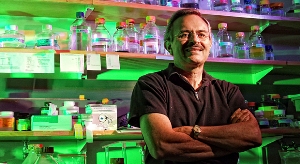Aug 21 2013
When David DeRosier first entered the University of Chicago as an undergraduate, he wanted to major in cosmology and study the universe. But, in the end, he decided to go smaller. Much, much smaller.

DeRosier, an emeritus professor of biology, spent much of his career peering through a microscope at life’s smallest building blocks. He pioneered the use of electron microscopy to make fundamental discoveries about cellular structures and is currently developing a new, super-resolution cryogenic light microscope as a postdoctoral fellow in neuroscientist Gina Turrigiano’s lab.
On Aug. 5, the Microscopy Society of America (MSA) honored DeRosier’s career with the Distinguished Scientist Award, the society’s highest honor. He joins the ranks of other renowned scholars who have received the MSA’s top award including his mentor, Nobel Prize recipient Aaron Klug.
“It is always quite nice to be recognized for achievements and contributions to the field,” DeRosier says of the honor.
This award joins the already long list of DeRosier’s achievements, including honors from the American Academy of Arts and Sciences and the National Academy of Science.
DeRosier began his career as postdoctoral fellow under Klug in Cambridge, England, at the same lab where James Watson and Francis Crick discovered the structure of DNA. At the time, the field of microscopy of biological macromolecular assemblies such as viruses was so small that DeRosier knew just about everyone involved. The limited power of the electron microscope meant that understanding such structures involved more guess work and imagination than quantitative analysis.
DeRosier and Klug developed 3D reconstruction from electron micrographs, which allowed scientists to examine proteins and other cellular structures directly. That discovery helped turn microscopy into a “whole new field,” DeRosier says.
Today, thanks in part to DeRosier’s contributions, that field has exploded. Scientists can see cellular structures all the way down to the atoms.
“I never dreamed that there would be such a steady stream of advances. Sometimes, it’s hard to keep up with everything happening,” DeRosier laughs.